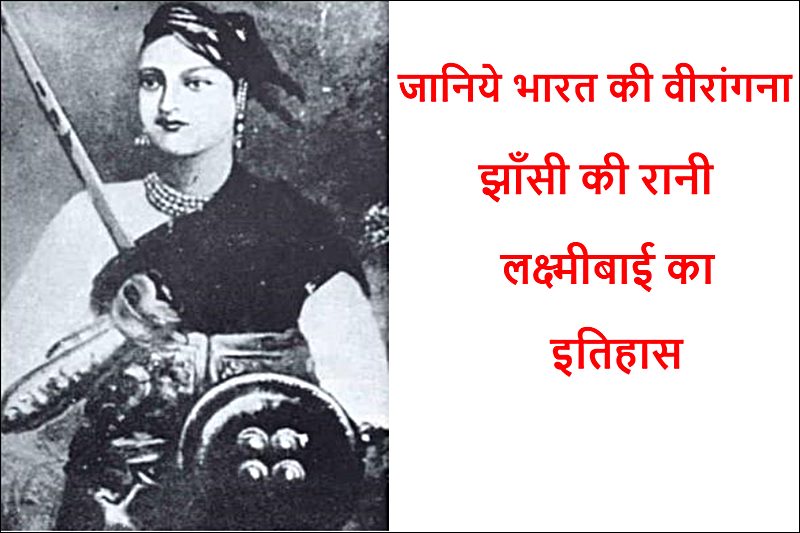The history of India is full of stories of many such heroes and heroines who did not care about their lives to protect the motherland. In this article, you will learn about one such heroine Rani Lakshmibai. Who shook the British rule with her bravery and courage. Apart from this, you will also get to know some special and important things related to Jhansi ki rani history in this article.
Jhansi Ki Rani History

The Rani of Jhansi was born on 19 November 1828 in Banaras. But according to some sources, she was born in 1835. She was named Manikarnika Tambe and was also called Manu in her childhood.
Manikarnika belonged to a Karhada Brahmin family. Her father’s name was Moropant Tambe and he was a commander during the war of Kalyan province. Her father Moropant Tambe used to work for Peshwa Bajirao-2 of Bithoor district.
Manikarnika’s mother’s name was Bhagirathi Sapre. When Manikarnika was 4 years old, her mother died.
Manikarnika’s marriage and her new name
Manikarnika Tambe was an advocate of women empowerment and protested against the patriarchal attitude towards women through her bold and unique works.
She was known for her unique perspective and for bravely standing up to the evils prevailing in society. Manikarnika was married to Maharaja Gangadhar Rao Newalkar of Jhansi in 1842. Gangadhar Rao Newalkar was the 5th Raja of Jhansi and a Karhada Brahmin.
After marriage, she started being called Lakshmibai. This is because according to the tradition of Maharashtra, women are given a new name after marriage.
In the year 1851, she gave birth to a boy whom she named Damodar Rao. But due to illness, he died just four months after birth.
After the death of Damodar Rao, the Maharaja adopted Anand Rao, son of his cousin Vasudev Rao Nevalkar before his death and renamed him Damodar Rao.
After the death of Manikarnika’s husband
Maharaja Gangadhar Rao Newalkar, husband of Rani Lakshmibai, died of illness on 21 November 1853. After his death, the British East India Company rejected Damodar Rao’s claim to the throne of Jhansi because Damodar Rao was the adopted child of the Maharaja.
Even after the death of her son and husband, Lakshmibai did not lose courage. At the time of Maharaja Gangadhar Rao Newalkar’s death, Lakshmibai was only 25 years old. And at the age of 25, all the responsibilities of Jhansi fell on her.
The British Governor General of that time, Lord Dalhousie, was very clever. He had his eyes on Jhansi and he wanted to usurp Jhansi by applying the policy of Doctrine of Lapse.
The British asked Rani Laxmibai to vacate the fort of Jhansi. But she refused to obey this order of the British and said, “I will not give away my Jhansi”.
After hearing this reply from Rani Lakshmibai, the British government attacked Jhansi. But this attack of the British was of no avail. Despite Rani Lakshmibai’s army being small, she gave a befitting reply to the British.
Battles fought by Rani Lakshmi Bai
When the revolt started in Meerut on 10 May 1857, Jhansi had many enemies by then. To be precise, Jhansi was surrounded by enemies.
Rani Lakshmibai started forming an army to fight her enemies. She also formed a women’s army which she named Durga Dal.
The queen made Jhalkari Bai the head of the Durga Dal. Jhalkari Bai was a look-alike of Rani Lakshmi Bai. Therefore, many times Jhalkari Bai used to go to war as Rani Lakshmi Bai.
In January 1858, the British army started marching towards Jhansi. By March, Jhansi was surrounded and the British attacked Jhansi. In this war, the British captured the whole of Jhansi.
But Rani Lakshmibai successfully escaped from there with her son Damodar Rao. After escaping from Jhansi, she reached Kalpi and met Tatya Tope there.
Later, Rani Lakshmibai and Tatya Tope, along with the rebel soldiers of Gwalior, captured a fort in Gwalior.
The last battle of Rani Laxmibai
This happened on 17th June 1858, when Captain Heneage found a large army led by Queen Lakshmibai at Kota-ki-Sarai in Gwalior.
At that time, a very fierce battle took place between the British and Rani Lakshmibai’s army. Thousands of soldiers were killed in this. On June 18, 1858, while fighting the British army, she suffered serious injuries in many places and ultimately she attained martyrdom. Three days after her death, the British captured Gwalior.
Conclusion

Rani Lakshmibai was educated at home during her childhood. Apart from this, she was taught many things like horse riding, swordsmanship, shooting, etc.
Apart from being beautiful, Rani Lakshmibai was extremely courageous and intelligent. She never bowed her head before the British. On the contrary, she always faced the British bravely.
Rani Lakshmibai took the responsibility of Jhansi state at a very young age. She set an example for everyone at that time that a woman can also lead a state and an army. And she is no less than a man.
At the age of just 29, she attained martyrdom while fighting. Even today people salute her bravery from the heart. If you want to ask or share anything related to this article, you can comment us. Apart from this, you must share this article so that people get to know about the brave women of our country.
Read More : Chhatrapati Shivaji Maharaj
FAQ (Frequently Asked Questions)
What were the names of Rani Lakshmibai’s horses?
The names of Rani Lakshmibai’s horses were Badal, Sarangi, and Pawan.
On which horse did Rani Lakshmibai escape from the fort in 1858?
Rani Lakshmi Bai fled from the Jhansi fort on her horse named Badal.
How did Rani Lakshmi Bai of Jhansi die?
When Rani Lakshmibai was fighting her last battle with the British army in Gwalior, she suffered very deep wounds. Even then she did not fall into the hands of the British and reached a nearby hut. She gave up her life in that hut and attained martyrdom.
